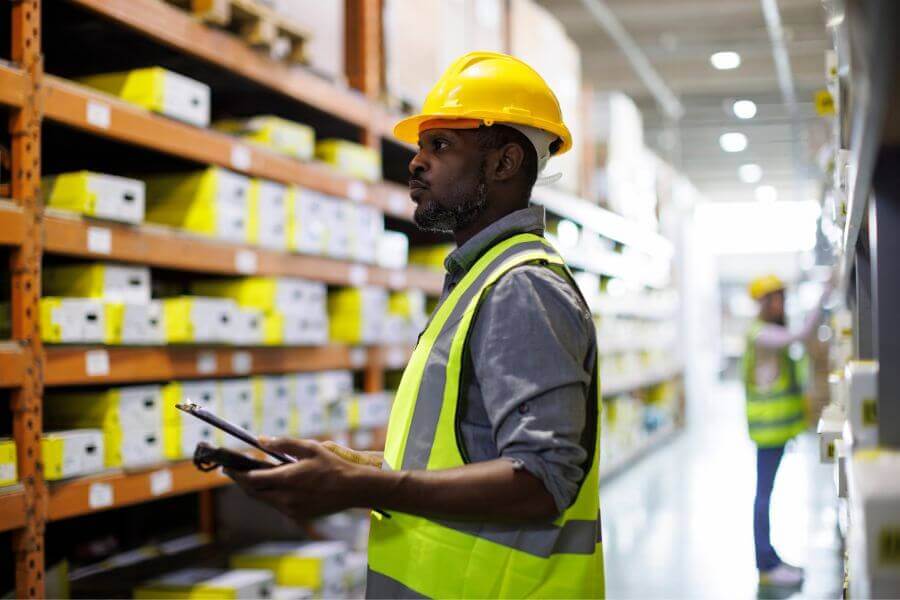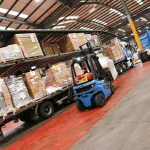
Smart Logistics in Kenya: Integrating RFID and IoT Technology with Traditional Wooden Pallet Systems
Introduction to Smart Logistics in Kenya
Kenya’s logistics sector is undergoing a transformation. With rapid growth in manufacturing, e-commerce, and export industries, businesses are under pressure to make their supply chains faster, more transparent, and more efficient. Technology—particularly RFID (Radio-Frequency Identification) and IoT (Internet of Things)—is emerging as a key driver in this shift.
Yet, while advanced tech is making waves, the humble wooden pallet remains the backbone of goods handling in Kenya. From supermarkets in Nairobi to exporters in Mombasa, wooden pallets dominate because they’re cheap, readily available, and easy to repair.
This opens up a unique opportunity: combining modern tracking and data capabilities with the traditional pallet infrastructure most businesses already use. Instead of replacing pallets with expensive smart alternatives, Kenyan companies can integrate RFID tags and IoT sensors into their existing systems, creating a hybrid smart logistics model that offers efficiency without massive capital investment.
Understanding RFID and IoT in Logistics
To appreciate the benefits of integrating RFID and IoT with wooden pallets, it’s essential to understand what these technologies are and how they work.
1. What is RFID and How It Works
RFID uses small electronic tags that store data and can be read wirelessly by scanners. Unlike barcodes, RFID tags don’t require line-of-sight scanning—they can be detected even when hidden inside packaging or loaded containers. This means pallets can be scanned in bulk as they pass through a checkpoint, saving time and reducing manual errors.
2. The Role of IoT in Modern Supply Chains
IoT refers to a network of connected devices—like sensors, trackers, and gateways—that communicate and share data over the internet. In logistics, IoT can be used to monitor the location, condition, and movement of goods in real time.
3. Benefits of Combining RFID and IoT
When RFID is integrated into an IoT-enabled system, businesses get both identification and real-time monitoring. For example, a pallet with an RFID tag and IoT temperature sensor can be tracked from Nairobi to Kisumu, with live updates on whether it’s in the right place and whether the goods are stored under safe conditions.
The Continued Role of Wooden Pallets in Kenya
Wooden pallets are not going anywhere anytime soon in Kenya. They are the workhorses of the logistics sector—used in warehouses, shipping yards, retail distribution centers, and even informal markets.
1. Why SMEs and Large Companies Still Prefer Wooden Pallets
-
Cost-effectiveness – Wooden pallets are much cheaper than plastic or metal alternatives.
-
Local availability – They can be sourced from local carpenters or pallet suppliers almost anywhere in Kenya.
-
Repairability – Damaged pallets can be fixed quickly without specialized tools.
2. Cost Advantages and Availability
In Kenya, a standard wooden pallet might cost between KSh 1,000 and KSh 2,500, compared to plastic pallets that can cost over KSh 5,000 each. This affordability makes them the go-to option for both small traders and large manufacturers.
3. Challenges with Traditional Wooden Pallet Systems
-
Lack of traceability—pallets are often lost or stolen.
-
Susceptibility to weather damage and pests.
-
No built-in tracking or monitoring features.
This is exactly where RFID and IoT integration can bridge the gap, adding digital intelligence to traditional wooden systems.
Integrating RFID with Wooden Pallet Systems
Embedding RFID into wooden pallets transforms them from simple carriers into smart logistics assets.
1. How RFID Tags Can Be Embedded or Attached to Pallets
RFID tags can be nailed, screwed, or glued onto the pallet’s frame, or embedded inside the wood during construction. Tags are designed to withstand handling, stacking, and transportation conditions.
2. Tracking and Monitoring Pallet Movements
Once tagged, pallets can be scanned automatically at key points—such as warehouse gates, loading docks, and delivery points—creating a digital trail of their movements.
3. Enhancing Inventory Visibility
With RFID integration, businesses can instantly check how many pallets are in stock, where they’re located, and whether they’re in use. This eliminates the guesswork and reduces the loss rate of pallets, which is a major cost problem for many Kenyan companies.
Leveraging IoT for Real-Time Pallet Data
RFID tells you what and where—IoT adds the how.
1. Sensors for Location, Temperature, and Humidity Monitoring
IoT sensors attached to pallets can track environmental conditions, ensuring goods like fresh produce, pharmaceuticals, or sensitive electronics are stored and transported correctly.
2. Using Cloud Platforms for Live Data Access
Data from IoT sensors can be transmitted to a cloud-based dashboard, accessible from a smartphone or computer. Logistics managers can monitor deliveries in real time and make quick decisions when issues arise.
3. Preventing Losses and Damages
Real-time alerts—such as when a pallet goes off-route, experiences a temperature spike, or is dropped—allow businesses to take corrective action before goods are ruined.
By combining IoT sensors with RFID, Kenyan businesses can track, monitor, and protect goods more effectively without abandoning the wooden pallet systems they already rely on.
Benefits of a Hybrid RFID-IoT Wooden Pallet System for Kenyan Businesses
The integration of RFID and IoT technology into wooden pallet systems creates a hybrid logistics solution that delivers the best of both worlds—traditional durability and modern intelligence.
1. Cost-Effective Modernization
Instead of replacing all pallets with expensive smart alternatives, Kenyan companies can retrofit existing wooden pallets with RFID tags and IoT sensors. This keeps costs low while still upgrading operational capabilities.
2. Improved Asset Tracking
RFID provides instant pallet identification, while IoT offers continuous monitoring. Together, they help businesses keep track of pallets in warehouses, during transit, and at customer locations, drastically reducing loss and theft.
3. Enhanced Supply Chain Visibility
With every pallet movement recorded digitally, managers can see where goods are at any moment. This reduces delays, improves delivery accuracy, and supports better decision-making.
4. Better Compliance and Reporting
Industries like pharmaceuticals, food, and agriculture often require strict tracking of goods from source to delivery. RFID and IoT-enabled pallets automatically generate audit trails, simplifying compliance with Kenyan and international regulations.
Challenges of Implementing RFID and IoT with Wooden Pallets
While the benefits are substantial, Kenyan SMEs and logistics providers should be aware of potential hurdles.
1. Initial Investment Costs
Although cheaper than full smart pallet systems, RFID and IoT retrofitting still require upfront spending for tags, sensors, and scanning infrastructure.
2. Technical Expertise
Businesses need trained staff to install, manage, and maintain RFID-IoT systems. Lack of technical know-how can hinder adoption.
3. Connectivity Limitations
In remote parts of Kenya, internet and mobile network coverage may not be reliable, making real-time IoT tracking challenging.
4. Pallet Durability Concerns
Since wooden pallets are subject to wear and tear, RFID tags and sensors must be rugged enough to withstand rough handling and harsh weather.
Best Practices for Successful Integration
For Kenyan companies to reap the full benefits of RFID-IoT-enabled wooden pallets, the rollout should be strategic and well-planned.
1. Start with a Pilot Program
Select a small number of pallets for RFID-IoT integration, monitor results, and refine processes before scaling up.
2. Use Durable, Weather-Resistant Tags
Kenya’s logistics networks include hot, humid coastal areas and dusty inland routes, so tags must be resilient in diverse conditions.
3. Train Staff Thoroughly
Operators, warehouse managers, and drivers should understand how to handle tagged pallets, use scanning devices, and troubleshoot basic tech issues.
4. Integrate with Existing Systems
Link RFID-IoT pallet data with current Warehouse Management Systems (WMS) or Enterprise Resource Planning (ERP) software for seamless operations.
Case Study: Kenyan Fresh Produce Exporter
A Mombasa-based fresh produce exporter faced recurring losses due to delays, spoilage, and missing pallets. They implemented a hybrid system by:
-
Embedding RFID tags in their wooden pallets.
-
Adding IoT sensors to monitor temperature and humidity.
-
Using a cloud dashboard to track shipments in real time.
Results after 6 months:
-
Reduced pallet losses by 45%.
-
Cut spoilage rates from 12% to 5%.
-
Improved on-time deliveries by 30%.
The investment paid for itself within a year, proving that RFID-IoT pallet integration can be both practical and profitable in Kenya’s logistics sector.
The Future of Smart Pallet Systems in Kenya
As Kenya’s logistics market continues to modernize, RFID and IoT-enabled pallets are likely to become industry standards—especially for high-value and sensitive goods.
Trends to watch:
-
Wider adoption of cloud-based logistics platforms that integrate pallet tracking data.
-
Increased use of renewable energy IoT devices, such as solar-powered GPS trackers.
-
Expansion of 5G networks in urban areas, enabling faster and more reliable real-time tracking.
Businesses that start adopting these hybrid systems now will gain a competitive edge, reduce losses, and improve supply chain efficiency for years to come.
Conclusion
Kenya’s logistics sector doesn’t have to choose between tradition and innovation. By integrating RFID and IoT technology with traditional wooden pallets, businesses can enjoy the cost benefits of existing infrastructure while unlocking the power of real-time tracking, monitoring, and data-driven decision-making.
This hybrid approach offers a practical path to smart logistics—one that’s affordable, scalable, and tailored to Kenya’s unique supply chain realities.
FAQs
1. Can RFID tags be reused after a pallet is retired?
Yes, RFID tags can often be removed and reattached to new pallets.
2. Do RFID-enabled pallets require a constant internet connection?
No—RFID works offline. However, IoT sensors require periodic or constant connectivity for real-time updates.
3. How long do IoT pallet sensors last?
Most run on batteries that can last from several months to over a year, depending on usage and transmission frequency.
4. Is it expensive to integrate RFID into wooden pallets?
It’s more affordable than replacing pallets entirely—retrofitting can start from as little as KSh 500 per pallet for basic RFID tags.
5. Can this system work for cross-border logistics?
Yes—RFID-IoT pallets are particularly useful for tracking goods in Kenya-Uganda-Tanzania trade routes, ensuring goods arrive safely and on time.





Add a comment